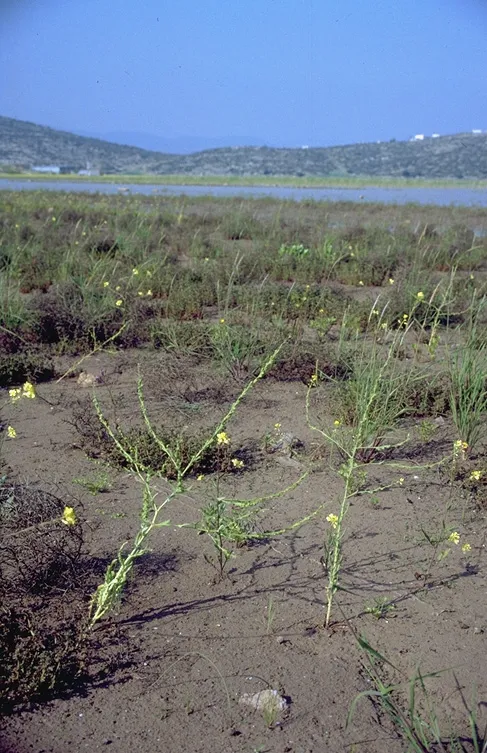Herb Sophia, Flixweed
Descurainia sophia


The seeds of Descurainia
sophia are used some as
an oil producing plant similar to mustard seeds. Its seeds are as used to attract mosquitoes and
gnats to insect traps.
At this time Descurainia
sophia has only been
found twice in
the Judean Mountains, in
Jerusalem, in
the Matsleva Valley in 1926 and in Bet Safafa in southern Jerusalem in 1987. The species is noted in the Flora Palaestina from the Arava, and consequently also
in plant guides, although there is no evidence of this (possibly mistakenly
identified and confused with Sisymbrium).
Gardens, orchards and roadsides in high
mountains and in the transition
zone. In Edom, it is common in irrigated orchards in the Petra area.
The genus Descurainia
has 40 species,
mostly herbaceous annuals and perennials that
grow in the temperate areas of the Northern
Hemisphere. The genus center is in North America, while the center of
the genus Sisymbrium, a related taxon, is in the Old World. One species grows in South Africa. The shape of the flower and fruit pedicels are slender similar to S. irio. Descurainia differs
from Sisymbrium mostly by its narrow-lobed leaves and its pod, which completely
lacks a beak. D. sophia
is also very similar to the species of the genus Arabidopsis, which differs from Descurainia by its long fruits and dissected leaves.
·
Descurainia sophia is a very rare
species found at two sites in
an urban area that
is very vulnerable.
·
It
probably has a
seed bank
at the site, similar to other annual species.
·
D.
Sophia is not globally endangered.
A field survey should be conducted to try to
find Descurainia in the traditional orchards
in the Judean area. If extinct, plants should be
introduced from Jordan and restored in a special reserve dedicated
to high transition zone plants that grow in harmony with traditional
agriculture.
Descurainia sophia has a very broad distribution: all the
Mediterranean countries, including the countries of the Maghreb, Central
and Western
Europe, the
countries of the Black Sea, the Caucasus, western and eastern Siberia, Sudan, Pakistan and India; in the Middle East: Egypt (coastal
region), southern Sinai, most Syrian regions, Lebanon, Turkey, Iraq and Iran. In Australia, South Africa and in the China-Japan area, D. sophia is considered
an alien species.
Its presence in North America goes back to the last 150 years. Some consider its range in the central European region to
Siberia secondary,
and that it penetrated to the region in the Middle Ages, and that Descurainia was
originally a Middle Eastern plant that adapted very well to human farming
culture.
Descurainia sophia
is an annual species that is almost extinct in Israel: it
grows only in Jerusalem and was last found in 1987. On one hand, it can be considered as a
type of episodic species that does not maintain a permanent population. The
fact that it is an annual species whose habitat is at the edges of gardens and
fields and its colonizing character support this view. On the other hand, D. sophia is
relatively common in Jordan's high transition zone, and is thus similar to
other species that have been collected a few times in the past in the Jerusalem
and Mount Hebron areas, such as Viola pentadactyla, Onopordum
macrocephalum, Aethionema carneum, Acinos rotundifolius and Lallamantia
iberica. These are part of the
ecological group of high transition zone plants. Their extinction since the 1940s is, in
our opinion, due to the drastic decrease of traditional agriculture and the massive
construction in the Jerusalem area. Thus,
the following species became extinct in the Matsleva Valley (even though it is still
a public park with natural areas): Viola modesta, V. pentadactyla,
Gagea bohemica, Salvia palaestina, Smyrnium connatum, Descurainia
sophia and Iris vartanii. The
following species that belong to this group are also extinct in the Jerusalem
area: Crocus palaestinus, Salvia bracteata, Legousia hybrida, S. multicaaulis and Malcolmia exacoides. Despite the efforts of botanists and participants
in the rare species survey, which was specially conducted in Jerusalem in 2001,
they were not found. However,
some plants were recently seen at the edge of fields in
the Ma'on Ridge, where traditional agriculture is still practiced. We therefore recommend that action
should be taken to preserve this group of species together the traditional
habitats they occupy, with emphasis on Descurainia, Acinos
and Viola pentadactyla, which can be included in the list of red plants in
Israel.
Current Occupancy Map
| 1000 squre meter pixel | 5000 squre meter pixel | 10000 squre meter pixel | |
|---|---|---|---|
| number of observations | 0 | 0 | 0 |
| in total pixels | 0 | 0 | 0 |
| Family | Brassicaceae |
| Classification | On the episodial species list |
| Ecosystem | High Semi-Steppe |
| Chorotype | Multi-Regional: Euro- Siberian, Mediterranean and Irano-Turanian |
| Conservation Site | Bet Safafa and Sha'afat in Jerusalem |
| Rarity |
1
6
6
|
|---|---|
| Vulnerability |
0
2
4
|
| Attractiveness |
0
0
4
|
| Endemism |
0
0
4
|
| Red number |
1
4.2
10
|
| Peripherality | 0 |
| IUCN category | DD EW EX LC CR EN VU NT |
| Threat Definition according to the red book | Endangered |
 Based on:
Based on:






